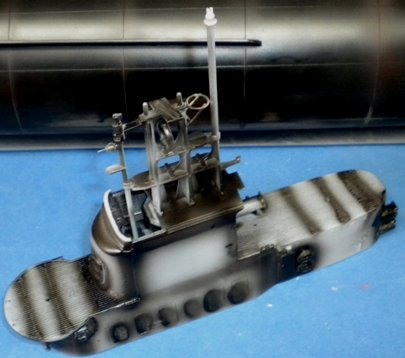

Aside from that, some parts for the conning tower and periscopes and of course that huge propeller and not a huge amount more. Well you certainly get a big box for your near £70.00 outlay but what’s inside? Let’s take a look…īlimey! Where is it? OK, a slight over-reaction but what you immediately see are some large sections for each side of the hull that is broken down into vertical sub-assemblies. The captain wanted to give the photographer in the helicopter maximum waves for color contrast. BTW, we were not “on the step” for this pix. Those ball caps were specifically authorized by the CO and the commander of Sub Squadron 2 at New London Sub Base (in Groton, CT) as they weren’t the ‘typical’ Navy ‘blue and gold’ colors used elsewhere in the fleet.

Hard to see, but note the greenish ball cap on the lookout (green with gold lettering). That’s the CO in khakis (CDR Anderson) and the lookout is a sonar tech, whose name I can not remember. The picture of the Shark (below) was taken ca. This also reduced ‘surface time’ minimizing our exposure to foreign detection by visual, radar and satellite. This maneuver made surface transits that much faster … until the boat could be dived in deeper waters. Sometimes, this was also referred to as “planning”. the wedging lifted the boat a little higher out of the water reducing hull resistance through the water. It sunk the propeller deeper into the water causing less cavitation (greater propeller efficiency) and 2. “full rise” on the stern planes to dig the stern deeper into the water (also causing the bow to lift up and now the boat was riding on top of a ‘wedge’ of water. “Full dive” on the stern planes to dig the bow deeper into the water, then 2. “The step” was a maneuver that would take hydraulic advantage of the hull’s teardrop shape by doing the following: 1. When on the surface on a flank bell (fastest speed), we would typically operate “on the step” to get a few more knots out of her. Even when doing special operations (spec ops) and rigging the boat for “ultra-quiet” left us with a somewhat detectable sound signature. The Skipjack class boats (the “S girls” as we were called) were not only very fast, but also very noisy. The USS Skipjack was the last submarine of that class to be retired on 19th April 1990. Until their decommissioning the six vessels of the Skipjack Class formed the senior unit of the US submarine fleet. When the USS Skipjack was transferred to the fleet on 15th April 1959, the US Navy received its first true submersible that could operate submerged for months at a time to secure the safety of fast-moving fleet units. The shipyard test run confirmed sensational performance with a top speed of over 30 knots when dived. The newly developed S5W nuclear reactor enabled her to remain submerged for a long period and her range was only limited by food stores. The six torpedo tubes in the bow could fire a total of 24 torpedoes. A visual feature was that the forward diving planes were fin-mounted for the first time.

The hull was a single pressure hull with circular cross-section made of high strength HY-80 steel. The USS Skipjack (SSN-585) was the first US Navy nuclear attack submarine with a hydro-dynamically optimized tear-drop shape. For further information visit or email - Move your mouse over image A little bit of background Revell model kits are available from all good toy and model retailers. Review by Geoff Coughlin (April 2013) Our thanks to Revell for supplying our review sample.


 0 kommentar(er)
0 kommentar(er)
